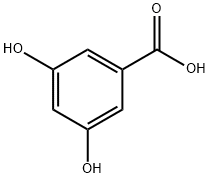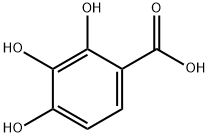3-Hydroxyphenylboronic acid
Synonym(s):m-Hydroxybenzeneboronic acid;3-Hydroxybenzeneboronic acid
- CAS NO.:87199-18-6
- Empirical Formula: C6H7BO3
- Molecular Weight: 137.93
- MDL number: MFCD01074603
- SAFETY DATA SHEET (SDS)
- Update Date: 2024-04-08 16:27:35

What is 3-Hydroxyphenylboronic acid?
Chemical properties
white to light yellow crystal powder
The Uses of 3-Hydroxyphenylboronic acid
3-Hydroxyphenylboronic acid (3-HPBA) can be used as a reagent:
- In Suzuki-Miyaura coupling reactions with aryl halides for the formation of C-C bond in the presence of Pd catalyst.
- ?To synthesize boron/nitrogen-doped polymer nano/microspheres by hydrothermal polymerization with formaldehyde and ammonia.??????
- To prepare carbon quantum dots based on 3-HPBA as selective fructose sensor.?????
- In the development of modified electrodes for electrochemical biosensors.
The Uses of 3-Hydroxyphenylboronic acid
suzuki reaction
Properties of 3-Hydroxyphenylboronic acid
| Melting point: | 210-213 °C (dec.) (lit.) |
| Boiling point: | 370.0±44.0 °C(Predicted) |
| Density | 1.32±0.1 g/cm3(Predicted) |
| storage temp. | Keep in dark place,Sealed in dry,Room Temperature |
| form | Crystalline Powder, Crystals and/or Chunks |
| pka | pK1:8.55;pK2:10.84 (25°C) |
| color | Pink to gray to tan |
| BRN | 3240771 |
| CAS DataBase Reference | 87199-18-6(CAS DataBase Reference) |
Safety information for 3-Hydroxyphenylboronic acid
| Signal word | Warning |
| Pictogram(s) |
 Exclamation Mark Irritant GHS07 |
| GHS Hazard Statements |
H315:Skin corrosion/irritation H319:Serious eye damage/eye irritation H335:Specific target organ toxicity, single exposure;Respiratory tract irritation |
| Precautionary Statement Codes |
P261:Avoid breathing dust/fume/gas/mist/vapours/spray. P304+P340:IF INHALED: Remove victim to fresh air and Keep at rest in a position comfortable for breathing. P305+P351+P338:IF IN EYES: Rinse cautiously with water for several minutes. Remove contact lenses, if present and easy to do. Continuerinsing. P405:Store locked up. |
Computed Descriptors for 3-Hydroxyphenylboronic acid
| InChIKey | WFWQWTPAPNEOFE-UHFFFAOYSA-N |
3-Hydroxyphenylboronic acid manufacturer
Denisco Chemicals Pvt Ltd
1Y
Phone:+91-9989050751
Whatsapp: +91-9989050751
product: 87199-18-6 3-Hydroxyphenylboronic acid 99%
New Products
(S)-3-Aminobutanenitrile hydrochloride 4-Methylphenylacetic acid N-Boc-D-alaninol N-BOC-D/L-ALANINOL Tert-butyl bis(2-chloroethyl)carbamate 3-Morpholino-1-(4-nitrophenyl)-5,6-dihydropyridin- 2(1H)-one Furan-2,5-Dicarboxylic Acid Tropic acid 1-Bromo-3,5-Di-Tert-Butylbenzene S-2-CHLORO PROPIONIC ACID ETHYL ISOCYANOACETATE 2-Bromo-1,3-Bis(Dimethylamino)Trimethinium Hexafluorophosphate 4-IODO BENZOIC ACID 3-NITRO-2-METHYL ANILINE 1-(2,4-DICHLOROPHENYL) ETHANAMINE (2-Hydroxyphenyl)acetonitrile 4-Bromopyrazole 2-(Cyanocyclohexyl)acetic acid 4-methoxy-3,5-dinitropyridine 1-(4-(aminomethyl)benzyl)urea hydrochloride 2-aminopropyl benzoate hydrochloride diethyl 2-(2-((tertbutoxycarbonyl)amino) ethyl)malonate tert-butyl 4- (ureidomethyl)benzylcarbamate Ethyl-2-chloro((4-methoxyphenyl)hydrazono)acetateRelated products of tetrahydrofuran








You may like
-
 87199-18-6 3-Hydroxyphenylboronic acid 99%View Details
87199-18-6 3-Hydroxyphenylboronic acid 99%View Details
87199-18-6 -
 87199-18-6 98%View Details
87199-18-6 98%View Details
87199-18-6 -
 87199-18-6 3-Hydroxyphenylboronic acid 99%View Details
87199-18-6 3-Hydroxyphenylboronic acid 99%View Details
87199-18-6 -
 3-Hydroxybenzeneboronic acid CAS 87199-18-6View Details
3-Hydroxybenzeneboronic acid CAS 87199-18-6View Details
87199-18-6 -
 3-Hydroxyphenylboronic Acid (contains varying amounts of Anhydride) CAS 87199-18-6View Details
3-Hydroxyphenylboronic Acid (contains varying amounts of Anhydride) CAS 87199-18-6View Details
87199-18-6 -
 3-Hydroxyphenylboronic acid CAS 87199-18-6View Details
3-Hydroxyphenylboronic acid CAS 87199-18-6View Details
87199-18-6 -
 14714-50-2 (2-Hydroxyphenyl)acetonitrile 98+View Details
14714-50-2 (2-Hydroxyphenyl)acetonitrile 98+View Details
14714-50-2 -
 118753-70-1 98+View Details
118753-70-1 98+View Details
118753-70-1
Statement: All products displayed on this website are only used for non medical purposes such as industrial applications or scientific research, and cannot be used for clinical diagnosis or treatment of humans or animals. They are not medicinal or edible.